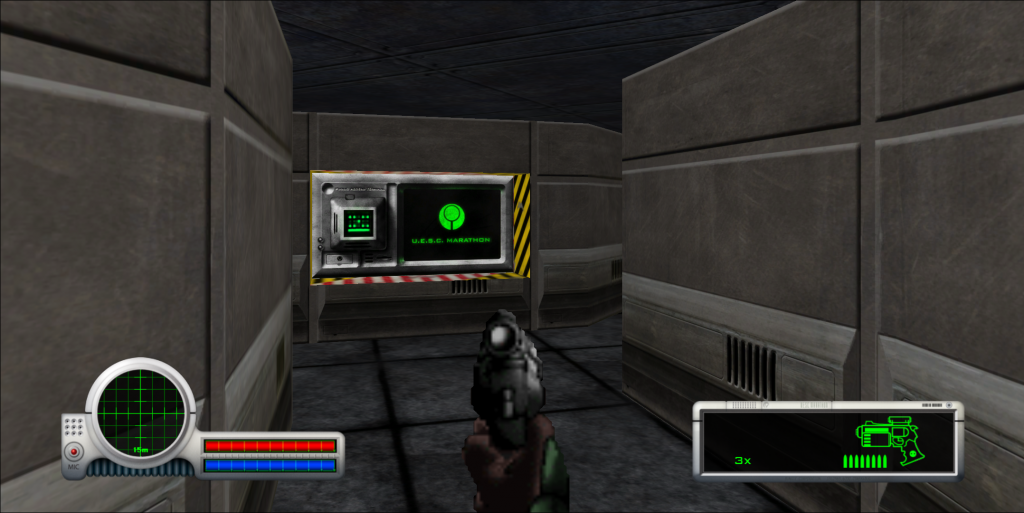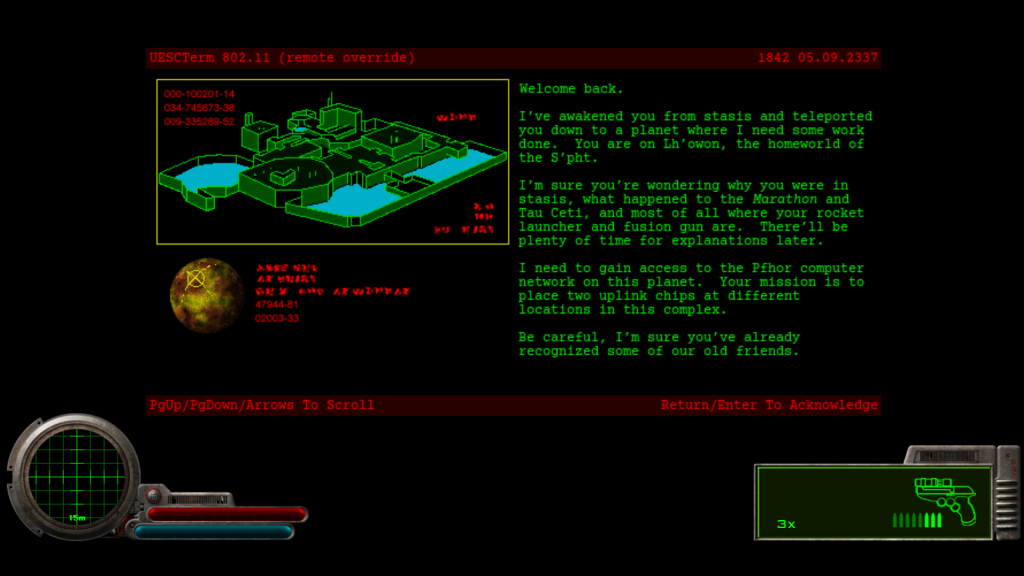Somewhere in the heavens… they are waiting.
I used to be a Mac gamer. I hung on every word of Steve Jobs’ keynotes – from the iMac to the iPod to the Nano to the iPhone. Just watch the first few minutes of the introduction of the iPhone or iPod Nano. It’s probably the best example of public speaking I can think of, and listening to Steve Jobs got me through speech classes and school presentations with flying colors. These days, Macs have sadly fallen by the wayside (as I type on my iPad) and Jobs’ push for perfection in simplicity is lacking. But for a while, Macs were the only way to go.
Why do I say all this? Because during my time as a Mac user and as a gamer, the one flaw of the Macintosh was the limited selection of games. The few we did get were spectacular, though. One in particular stands out – specifically, the Mac-only Marathon Trilogy.
And what a trilogy it was. Marathon was one of the first 3D games, released just a year after Doom. Like Doom, it had 3D maps where you had to run around pushing buttons and shooting things until something teleported you to the next level. Both Doom and Marathon had excellent enemy and weapon variety, truly fun mechanics, a fantastically quick movement speed, and some interesting (and sometimes …interesting) level design. I think the only reason Marathon isn’t just as popular as Doom is because it was originally only released on Macintosh – and I can prove it. But first, here’s why I think Marathon is superior to Doom: the story.
As I’ve already said, Marathon has equivalent mechanics to Doom – run, shoot, repeat. Health pickups are instead health stations (as found in Half Life) and I think the Marathon trilogy has more interesting level design overall, but things are otherwise pretty similar. But where Doomguy’s mission can be mostly summarized up with “demons bad. kill demons”, Marathon (and its sequels) have conspiracy-level forums dedicated to unraveling the plot. It starts out simple enough – aliens are trying to board your ship, so you are tasked with killing the aliens by one of the ship’s AIs. Things get more worse when you find out that the other two AIs on the ship are probably insane. Things get…a little more complicated over the next two games. The final installment, Infinity, was written with the express design of finding out exactly how complex a plot gamers could handle. It ends after jumping through several alternate realities and timelines until you can prevent the end of the galaxy by containing the W’rkncacnter, a chaotic being or beings that may or may not be an elder god. All of this is told or inferred through computer terminals (like the one above). With Doom, there is very little beyond exactly what you see on screen. In Marathon, Durandal, and Infinity, there are questions of free will, immortality, and the nature of the soul – if you spend the time to look. While you might not care about the story, it will always be there waiting for when you do.
Am I saying you shouldn’t play Doom? No – you can get zDoom for free and have a ton of fun. There’s literally no reason not to enjoy both of these Tier One games. But especially now that the source code has been released, chopped apart, and made into dozens of fan mods, you’re doing yourself a disservice if you don’t play through the Marathon trilogy at least once. The graphics may be dated, but the experience is even fresher than it was in 1994.
I said that I could prove that Marathon would have been more popular if it had been released on more platforms, right? Well, here you go. Bungie made the Marathon trilogy for Mac – then, they started work on a new game in the same universe. Before they released it, they were bought by Microsoft and the game was tweaked a bit. That game became a launch title for the original XBox, and you may have heard of it: Halo.

